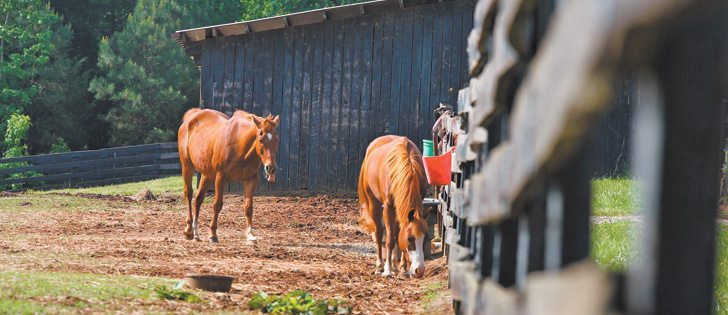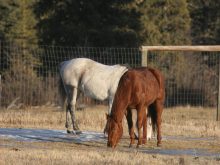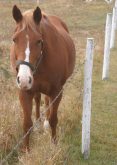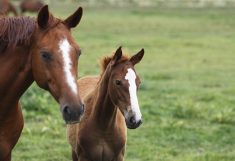With increasing parasite resistance and few new products on the market, fecal egg counts are used to design a control program
RED DEER — A new approach to parasite control has emerged as horse owners deal with resistance and the resurfacing of old pests.
“Some of the drugs we have used for awhile are starting to see resistance,” said veterinarian David Ellefson at the Mane Event, an equine show held in Red Deer April 27-29.
“Every time we deworm, we select for parasite resistance,” said Ellefson, director of technical services for Bimeda Inc., a veterinary medicine company.
No new products are coming on the market so dewormer management is changing.
Read Also

Manitoba extends Crown land rent freeze
Manitoba government links the continued rental rate freeze on grazing and forage leases to economic and environmental challenges facing the industry
Some worms carry a gene for resistance, some are susceptible to medications and some, known as SRs, may carry both genes. When a horse is dewormed, the susceptible worms die, the SRs will likely die and the resistant ones will survive.
Horse owners need to maintain a population of susceptible worms in the pasture because if they breed with the resistant variety, the next generation can be more vulnerable to treatments.
Owners should ask their veterinarians to do fecal egg counts instead of changing dewormers.
“The old idea of drug rotation isn’t really in vogue now,” Ellefson said.
In a fecal egg count, a sample goes under the microscope to assess the number of worms found in a gram of manure. The result is a rating of low, medium or high prevalence.
This prevalence level is a genetic quality in the horse. Some are able to resist parasites colonizing in their guts, and a low shedder will remain that way for life.
More than 500 eggs per gram means the horse is a high shedder, 200 to 500 eggs per gram is medium and fewer than 200 eggs per gram indicates a low shedder.
The next step is to start an individual control program based on the shedding capacity of each animal.
Treatments can be administered followed by another egg count in 14 days. There is probably a resistance problem if the egg count is not reduced by 95 percent. A different dewormer can be used because the treatments have different modes of action.
Horses deemed high shedders should be treated six to eight times per year, medium shedders three times per year and low shedders twice per year.
“Your vet is your best source of information and risk assessment for proper deworming of your horse,” Ellefson said.
A fecal count should be done when new horses are introduced and the deworming program is unknown. A broad spectrum product can also be used. New horses should be quarantined to make sure they are not carrying disease.
Do not give equine dewormers to dogs because they could overdose and die. Some dogs carry a gene that does not allow them to clear these products from their systems. Collies and other herding dogs are most at risk from an overdose.
Horses typically pick up parasites when grazing or eating hay. A horse in a stable is at less risk from getting parasites than if it is in a pasture, but it can still have an infestation because it was fed hay that may carry problem insects or larvae.
“Grazing is the key way a horse is going to pick up parasites. A single drop of dew can hold 20 to 30 parasites,” Ellefson said.
Parasites can cause colic, impactions and intussusception, in which one portion of the bowel telescopes into another section.
Common parasites include:
Tapeworms
Tapeworms are relatively new parasites for horse owners. They cause serious health problems if left untreated.
They live where the small and large intestines meet and can lodge in the cecum, which is like the appendix. They affect the movement of the gut and keep feed moving through. They are a leading cause of spasmodic colic. Impaction can occur at the junction of the gut and a blockage occurs.
Intussusception may also occur and the inside part of the intestine starts to die.
Horses can pick up tapeworms in pastures or other feedstuffs, where they ingest mites carrying the larvae. Parasites usually harm younger animals more, but tapeworms affect horses of all ages.
Blood tests can determine if the horse has tapeworms.
Studies have found that 90 percent of horses in the Great Lake region show they have been exposed to infestation.
It was estimated that more than half of the horses had been exposed in Ontario and a similar percentage in the northern tier states.
As a result, the same number in Alberta and Saskatchewan may be affected.
Three dewormers are on the market to take care of tapeworms and other parasites. Treatment for foals could start when they are one to two months of age with follow-ups every two months until they are 14 to 16 months old.
Large strongyles
Large strongyles used to be the most significant parasite in adult horses. The larvae are picked up during grazing and can migrate through the bloodstream and various organs.
They can cause diarrhea, depression, anemia, poor coat and colic. They may be 2.5 to five centimetres long.
Treatments in the European Union are available only by prescription so cases are increasing because horse owners do not want the trouble or expense of using a veterinarian.
Small strongyles
Small strongyles are the most problematic worm found in horses. They burrow into the wall of the gut and could cause colic.
Roundworms
Roundworms look like spaghetti and are a major problem for young horses.
The eggs can last for years in the environment because they have a tough outer shell to protect them against weather extremes.
They migrate from the gut to the liver and eventually the lungs. Horses cough from irritation, which is often mistaken for respiratory problems.
A horse that has a dull coat and big stomach but appears thin otherwise probably has roundworms.
Bot fly larvae
Adult bot flies attach eggs to the hair coat, and larvae that hatch there are eaten if the horse licks the area.
The larvae then enter the mouth and larvae lodge in the cheeks and tongue.
A dewormer will kill them, but sores may appear where the dead ones were found. Deworm horses 30 days after the first killing frost to reduce bot flies.
The horse may lose condition, have a poor appetite and a poor hair coat and may show signs of intestinal pain.
Pinworms
Pinworms cause horses to rub their rear ends against anything solid to get relief from the itching. They emerge at night and females lay eggs under the skin near the tail.
Horses can rub off a lot of tail hair and get a condition called broom tail. If a horse is passing worms, they are likely pinworms.
















